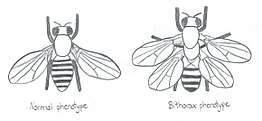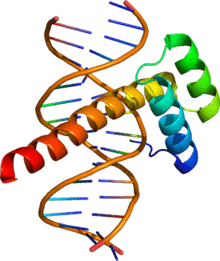Ultrabithorax
Ultrabithorax (Ubx) is a homeobox gene found in insects, and is used in the regulation of patterning in morphogenesis. There are many possible products of this gene, which function as transcription factors. Ubx is used in the specification of serially homologous structures, and is used at many levels of developmental hierarchies. In Drosophila melanogaster it is expressed in the third thoracic (T3) and first abdominal (A1) segments and represses wing formation. The Ubx gene regulates the decisions regarding the number of wings and legs the adult flies will have. The developmental role of the Ubx gene is determined by the splicing of its product, which takes place after translation of the gene. The specific splice factors of a particular cell allow the specific regulation of the developmental fate of that cell, by making different splice variants of transcription factors. In D. melanogaster, at least six different isoforms of Ubx exist.[2]

| Ultrabithorax | |||||||
|---|---|---|---|---|---|---|---|
 Crystallographic structure of ultrabithorax complexed with double stranded DNA.[1] | |||||||
| Identifiers | |||||||
| Organism | |||||||
| Symbol | Ubx | ||||||
| Entrez | 42034 | ||||||
| HomoloGene | 131181 | ||||||
| PDB | 4UUT | ||||||
| RefSeq (mRNA) | NM_206497.3 | ||||||
| RefSeq (Prot) | NP_996219.1 | ||||||
| UniProt | P83949 | ||||||
| Other data | |||||||
| Chromosome | 3R: 16.64 - 16.75 Mb | ||||||
| |||||||
Mutations of the Ubx gene will lead to transformation of dorsal and ventral appendages of the third thoracic segment (T3), which includes the haltere and third leg, into the counterparts on the second thoracic segment (T2). If Ubx is present in T3, it will prevent the original fate of the T2 segment. Such mutations can produce the second set of wings observed in the bithorax phenotype.
Structure
The Ubx gene contains a 5' exon, two micro-exons, an optional B element, and a C terminal exon. The Ubx genomic DNA length is 76 kb and its cDNA clone length is 3.2 to 4.6 kb. The 5' exon contains the 5'UTR which has 964 bases. The C terminal exon contains the 3'UTR which has 1580 to 2212 bases.
Target genes
Ubx targets hundreds of different genes at different stages of morphogenesis including regulatory genes such as transcription factors, signalling components and terminal differentiation genes.[3] Ubx has been shown to act upon long-range signaling molecules, as well as their target genes and subsequent genes further downstream. It has been shown to act at many levels of regulatory hierarchies, meaning Ubx can be used to as a signal more than once in the same regulatory hierarchy.[4]
Ubx represses selected Dpp (Decapentaplegic-activated) target genes in the anterior and posterior axis.[5] Several Dpp target genes which have been identified are spalt-related, vestigial, Serum Response Factor, and achaete-scute.[4] Ubx also represses Wingless in the posterior compartment of the dorsoventral axis. The products of these genes are used in the regulation of morphological features between the wing and the haltere.
Ubx also selectively represses one enhancer of the vestigial genes in the proximodistal axis.
Regulation
Ubx is activated when there is a certain lack of Hunchback (hb) protein. Significant concentrations of Hunchback only exist in the anterior and posterior regions of the embryo, therefore Ubx is expressed only in middle segments. Thus, the hb gene may play an important role in the specification of the boundaries of Ubx expression.[6]
Activation of Ubx involves multiple cis-acting regulatory sequences, which are found upstream and downstream of the mRNA cap-site. These enhancer regions can activate transcription of Ubx if the right combination of factors is present. For example, it has been shown that Ubx expression in the third femur of D. melanogaster is dependent on the enhancer regions abx and pbx.[7] Transcription factors which bind to the promoter site of Ubx have been purified and shown to activate expression of the gene in vitro.[8]
Expression of Ubx is repressed by the long non-coding RNA Bithoraxoid (Bxd), using transcriptional interference to silence expression.[9][10]
Ubx Biomaterials
Besides being a well known transcription factor, Ubx has been used to form biomaterials in vitro. Macroscale materials in the form of ropes, films and sheets can be generated from recombinant Ubx protein, which can self-assemble under gentler conditions than other biomaterial proteins.[11] The macroscale materials self-adhere, allowing them to assume more complex structures. In addition to requiring less harsh conditions than other proteins, Ubx has been shown to assemble more rapidly and at much lower concentrations.[11]
Ubx materials are mechanically robust. By altering fiber diameter, the breaking strength, breaking strain, and Young’s modulus can be tuned to values spanning an order of magnitude, ultimately changing the mechanism of extension.[12]
References
- PDB: 4UUS: Foos N, Maurel-Zaffran C, Maté MJ, Vincentelli R, Hainaut M, Berenger H, Pradel J, Saurin AJ, Ortiz-Lombardía M, Graba Y (February 2015). "A flexible extension of the Drosophila ultrabithorax homeodomain defines a novel Hox/PBC interaction mode". Structure. 23 (2): 270–9. doi:10.1016/j.str.2014.12.011. PMID 25651060.
- "FlyBase Gene Report: Dmel\Ubx". FlyBase. March 20, 2009. Retrieved 2009-04-23.
- Pavlopoulos A, Akam M (February 2011). "Hox gene Ultrabithorax regulates distinct sets of target genes at successive stages of Drosophila haltere morphogenesis". Proceedings of the National Academy of Sciences of the United States of America. 108 (7): 2855–60. doi:10.1073/pnas.1015077108. PMC 3041078. PMID 21282633.
- Weatherbee SD, Halder G, Kim J, Hudson A, Carroll S (May 1998). "Ultrabithorax regulates genes at several levels of the wing-patterning hierarchy to shape the development of the Drosophila haltere". Genes & Development. 12 (10): 1474–82. doi:10.1101/gad.12.10.1474. PMC 316835. PMID 9585507.
- Capovilla M, Brandt M, Botas J (February 1994). "Direct regulation of decapentaplegic by Ultrabithorax and its role in Drosophila midgut morphogenesis". Cell. 76 (3): 461–75. doi:10.1016/0092-8674(94)90111-2. PMID 7906203.
- White RA, Lehmann R (October 1986). "A gap gene, hunchback, regulates the spatial expression of Ultrabithorax". Cell. 47 (2): 311–21. doi:10.1016/0092-8674(86)90453-8. PMID 2876779.
- Davis GK, Srinivasan DG, Wittkopp PJ, Stern DL (August 2007). "The function and regulation of Ultrabithorax in the legs of Drosophila melanogaster". Developmental Biology. 308 (2): 621–31. doi:10.1016/j.ydbio.2007.06.002. PMC 2040266. PMID 17640629.
- Biggin MD, Tjian R (June 1988). "Transcription factors that activate the Ultrabithorax promoter in developmentally staged extracts". Cell. 53 (5): 699–711. doi:10.1016/0092-8674(88)90088-8. PMID 2897243.
- Petruk S, Sedkov Y, Riley KM, Hodgson J, Schweisguth F, Hirose S, Jaynes JB, Brock HW, Mazo A (December 2006). "Transcription of bxd noncoding RNAs promoted by trithorax represses Ubx in cis by transcriptional interference". Cell. 127 (6): 1209–21. doi:10.1016/j.cell.2006.10.039. PMC 1866366. PMID 17174895.
- Petruk S, Sedkov Y, Brock HW, Mazo A (2007). "A model for initiation of mosaic HOX gene expression patterns by non-coding RNAs in early embryos". RNA Biology. 4 (1): 1–6. doi:10.4161/rna.4.1.4300. PMID 17568198.
- Greer AM, Huang Z, Oriakhi A, Lu Y, Lou J, Matthews KS, Bondos SE (April 2009). "The Drosophila transcription factor ultrabithorax self-assembles into protein-based biomaterials with multiple morphologies". Biomacromolecules. 10 (4): 829–37. doi:10.1021/bm801315v. PMID 19296655.
- Huang Z, Lu Y, Majithia R, Shah J, Meissner K, Matthews KS, Bondos SE, Lou J (December 2010). "Size dictates mechanical properties for protein fibers self-assembled by the Drosophila hox transcription factor ultrabithorax". Biomacromolecules. 11 (12): 3644–51. doi:10.1021/bm1010992. PMID 21047055.